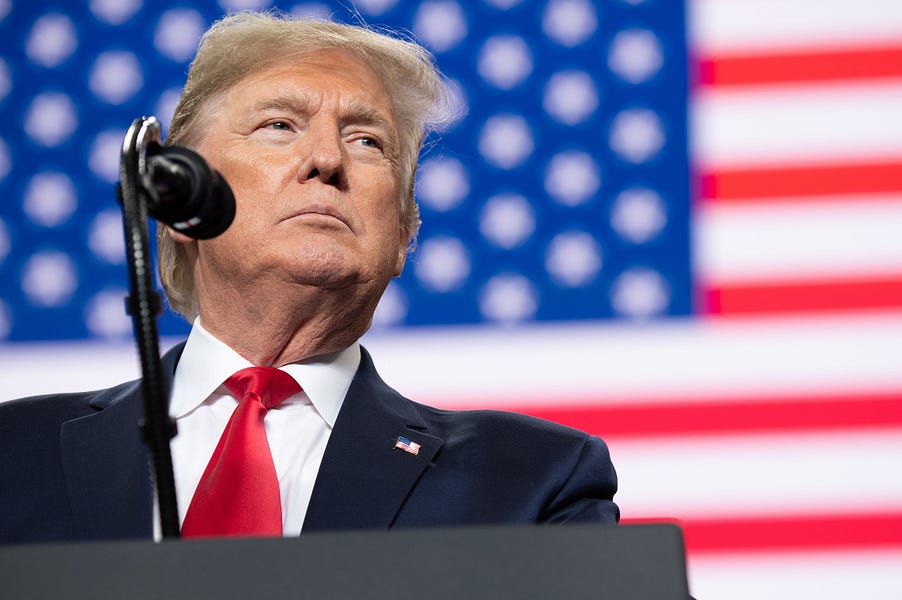On Friday, Donald Trump took to Twitter to accuse the social media platform of censoring a video from his campaign:
The Trump campaign had made the same accusation of censorship earlier in the week, via Twitter:
The video, which was also removed from Facebook but can still be watched on YouTube, features clips and images from the protests against police brutality against African Americans in the wake of the death of George Floyd, with a speech by Trump playing in the background. Here is one of the images that appears in a longer version of the video, which is available at the Daily Mail. (More on that below.)
The original tweet with the video now bears the message: “This media has been disabled in response to a report by the copyright owner.” The article the president linked to in his tweet questions whether a complaint was actually filed at all, with the author writing, “I don’t believe there was a copyright complaint filed, because the video is full of love and hope, and it was a great message to the American people. And if there was, no one can tell me that it wasn’t lodged because the leftist mob searched and found out who created the video and threatened the creator.”
The claim that no complaint was filed is incorrect: The complaint can be found on Lumen, a database of cease and desist letters run by Harvard University. The Lumen entry on the complaint is barebones, but notes that it was sent by the Law Office of Sam Koolaq in Burbank, California. Sam Koolaq confirmed to Politico that his firm submitted the complaint and had sent similar complaints to other platforms that featured the video. A representative from YouTube told Politico that the version of the video on their website differed from the one tweeted by Trump’s campaign and did not feature the copyrighted material.
The YouTube version of the video is 3 minutes 41 seconds long, while the Twitter version was 3 minutes 45 seconds long, according to the Wayback Machine’s archive of the tweet. The YouTube version appears to have been edited, as the archive of it shows that on June 4 the video was 3 minute 45 seconds long as well. Unfortunately, the video is not playable in the archive, though British media outlet The Daily Mail has a 3 minute 45 seconds version of the video, which, unlike the shorter version, includes the painting of Floyd shown above. It’s by freelance designer Shirien Damra, who runs a popular Instagram account featuring her activism art.
The shorter version of the video features a noticeable jump in the audio during the time when Damra’s painting is shown in the longer version of the video, with Trump saying “the death of George Floyd on the streets of Minneapolis was a grave tragedy” in the longer version, while the shorter version features him only saying “the death of George Floyd was a grave tragedy.”
Damra did not respond to a request for comment, but if, as seems the case, the inclusion of her artwork was what prompted the copyright complaint, the complaint is entirely valid. Deborah Gerhardt, a professor at UNC Chapel Hill’s law school and member of the school’s Intellectual Property Initiative, told The Dispatch Fact Check that while Damra’s painting may have been published solely in digital form on social media, it still receives the same protections as a traditional work of art would.
“If you are an artist and you make a painting, you have the right to decide whether it will be displayed at all,” said Gerhardt.
“If I take a photograph and I put it on Instagram, I’ve chosen to publish it on Instagram, but it doesn’t give the right for someone else to publish it somewhere else. … It’s the exclusive right of the artist to publicly display [their work]. Just because the artist chose to publicly display it on Instagram doesn’t mean that somebody else gets to publicly display it in an ad.”
And in cases where copyright infringement occurs on online platforms, those companies have to remove infringing content they’re notified about or risk getting sued.
Gerhard explained that “Congress passed a law called the DMCA [Digital Millennium Copyright Act], which basically provides a safe harbor for organizations like those that provide digital platforms for other people to share content. The safe harbor says that the Twitters and Googles, all those companies that let other people share content, they are not liable for copyright infringement if they appoint a DMCA agent so that anybody that thinks content has been infringed can go to the DMCA agent and say ‘something on your platform is infringing copyright, I want you to take it down.’”
Considering the relevant laws, President Trump and his campaign err in describing the removal of the campaign video as censorship. It included content protected by copyright law, which, following a complaint, created an obligation for Twitter and other platforms to remove the video in order to abide by the DMCA.
If you have a claim you would like to see us fact check, please send us an email at factcheck@thedispatch.com. If you would like to suggest a correction to this piece or any other Dispatch article, please email corrections@thedispatch.com.
Photograph by Saul Loeb/AFP/Getty Images.







Please note that we at The Dispatch hold ourselves, our work, and our commenters to a higher standard than other places on the internet. We welcome comments that foster genuine debate or discussion—including comments critical of us or our work—but responses that include ad hominem attacks on fellow Dispatch members or are intended to stoke fear and anger may be moderated.
With your membership, you only have the ability to comment on The Morning Dispatch articles. Consider upgrading to join the conversation everywhere.